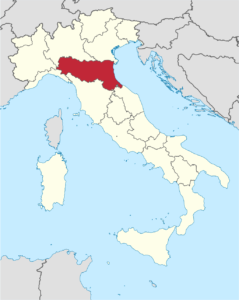EMILIA-ROMAGNA

Location
A rich, fertile region in northern Italy. It spans almost the entire width of the northern Italian peninsula, sandwiched between Tuscany to the south, Lombardy and Veneto to the north, and the Adriatic Sea to the east
Grape Variety:
Lambrusco: Emilia-Romagna is renowned for its fizzy red wines made from the Lambrusco grape variety. The five Lambrusco DOCs (Salamino di Santa Croce, di Sorbara, Grasparossa di Castelvetra, Modena, and Reggiano) are particularly notable.
Malvasia: This white grape variety thrives in the region.
Trebbiano, Barbera, Bonarda, and Sangiovese: These are other important grape varieties used in Emilia-Romagna’s wine production.
Climate:
The region’s geographical diversity significantly influences its terroirs:
Western Hills and Apennine Peaks: Rolling hills and Apennine peaks dominate the western part of Emilia-Romagna.
Lower-Lying Plains: East of Parma, Modena, and Bologna, the landscape transitions to lower-lying plains.
Coastal Plains: In the Ferrara province, a portion of the land lies just below sea level.
The river Po flows west to east across the region, moderating temperatures and providing cooling breezes to vineyards.
History:
Emilia-Romagna’s viticultural heritage dates back to ancient times. The Etruscans introduced vines here, and later, the Romans used the Via Aemilia road (from which the region derives its name) to transport wine between cities.
Interestingly, the vine varieties used for centuries were of the Vitis labrusca species, different from the Vitis vinifera used globally today.
Famous Wines:
Lambrusco wines, especially those from the various Lambrusco DOCs, are the stars of Emilia-Romagna.
Other notable wines include Albana di Romagna and Colli Bolognesi Pignoletto.
Emilia-Romagna produces a roughly equal amount of white and red wines, showcasing its diverse grape varieties